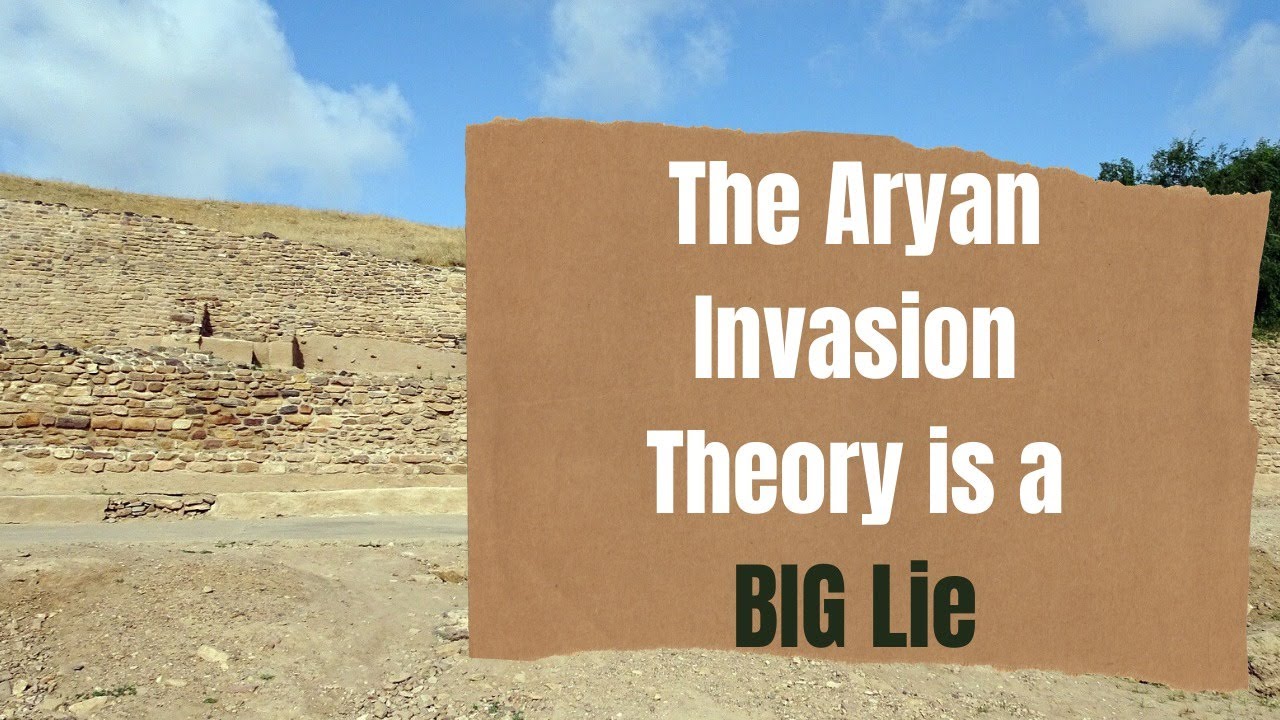Rejecting the Myth of the Aryans: A Primer — Part I
Image Courtesy: YouTube.com
The dominant story about ancient India is the AIT (Aryan Invasion Theory) or its softer version, AMT (Aryan Migration Theory). The debates surrounding this matter are both contentious and vigorous. This essay in two parts gives an overview of the scholarship which not only rejects the AIT but proposes an alternative version or the Out of India (OIT) hypothesis. This work draws primarily from the works of Michel Danino, Shrikant Talageri, and Koenraad Elst. Part II can be accessed here.
Introduction: The Basic Story of the Aryans
The dominant theory regarding ancient Indian civilization is the AIT (Aryan Invasion Theory) proposed first in the 19th century. This postulates a group of horse-riding invaders called the Aryans, speaking an early form of Sanskrit, from Central Asia, invading North India around 1500 BCE where and when there was an existing Harappan civilization. These light-skinned Aryans defeated the dark-skinned racially different indigenous natives of the Harappan Civilization called Dasas and Dasyus and drove them south.
The subjugated population adopted the language, religion, and the Vedic culture of the invaders and agreed to stay at the bottom of a hierarchical scale as slaves and Sudras in the Aryan devised varna system. The Dāsas and Dāsyus, correlating with the Harappans, were the ancestors of today’s tribals, Sudras, Dalits, and Dravidians.
In the newer and softer versions, the Aryans migrated peacefully into the subcontinent (the Aryan Migration Theory or AMT). However, the implications remain the same.
Ironically, the original homeland of these Aryans was speculated to be in India but it later shifted across various regions to settle now in the Russian Steppes. German Indologists involved themselves aggressively in the AIT constructions. Max Mueller speculated, “how the [British] descendants of the same [Aryan] race, to which the first conquerors and masters of India belonged, return … to accomplish the glorious work of civilization, which had been left unfinished by their Aryan brethren”. The British justifications portrayed their new colonial rule as one more Aryan wave.
The Aryan settlers, in a remarkably brief time after 1500 BCE, first created the near perfect language of Sanskrit and then composed the Rig Veda around 1200 BCE. They later moved into the Ganges Valley by clearing the thick forest cover of the Gangetic plains with their strong iron tools. This AIT/AMT story has a two-century history of propagation by academics relying on disciplines like archaeology, linguistics, and textual/inscriptional data.
The Major Problems with AIT/AMT
Similarities between Sanskrit and other European languages (noted by William Jones and Jesuit scholars) led to the idea/hypothesis of a common precursor Proto-Indo-European (PIE) language and a common homeland to which the language belonged. From here, people and languages migrated to different lands. Thus, the Aryan invasion/migration theories began with linguistics.
However, the evidence for Aryans invading/migrating remains slim, especially in archaeology. The discovery of the Harappan civilization much before independence flew in the face of the Aryan Invasion Theory. Yet, the powerful post-independent Marxist historians continued with their speculations and assertion about “invading Aryans” and the “exploited Dravidians” fitting well with their exploiter-exploited paradigm. Aryans simply filled our textbooks. Data from genetics, a new weapon for the AIT/AMT proponents today, remains ambiguous and contradictory.
The original homeland of the Aryans speculated in 1800 was India since scholars thought of Sanskrit as the mother language. However, this went into hibernation as the idea of invasion became popular. There is now a strong scholarship which shows that linguistics and textual data strongly support the rival OIT or “Out of India” theory in which India is proposed as the original homeland. The theory gained ground once again in the early 1990s as various scholars offered support for this hypothesis. Textual sources like the Vedas, as scholars like Talageri show, offer narratives of a reverse migration – i.e., people moving from India to different parts of Europe.
It is irrelevant whether Aryans existed, according to some scholars. That may be true, but it is a fact that most narratives disrupting the fabric of India are based on AIT/AMT. The indigenous people of India driven south became the Dravidians. Those pushed into forests became the tribals (Adivasi/Vanavasi), and the people who stayed back became subjugated as the lowest in the hierarchy of the caste system (Shudras, and especially the “untouchables”). The most pernicious outcome of the AIT/AMT hypotheses is the well-entrenched narrative of the dominant, upper caste “Hindus” trying to always exploit and subsume Dravidians, tribals, and Dalits into a Vedic-Sanskritic-Brahmanical culture. In this narrative, Sanskrit as a language becomes oppressive and, being the carrier of Vedas, stands in opposition to non-Vedic cultures and Dravidian languages.
However, despite all evidence to the contrary, Indians seem to have simply internalised this story and even built a huge edifice of conclusions based on the AIT/AMT assumptions. The major repercussion has of course been a near permanent fissure in relations between the North and the South with political movements based on a “pure” Dravidian identity.
Koenraad Elst, in his seminal work Still No Trace of an Aryan Invasion, summarizes the many political applications of the racially interpreted AIT:
- The colonial justification of the rule by the pure Aryans (the British) over the mixed Aryans (the upper castes) and the black aboriginals (the lower castes)
- The Nazi scheme of rule by the pure Aryan race and the degeneracy of India-based Aryans through mixing with lower races
- Anti-Brahminism
- Dravidianism
- Ambedkarism (lower castes as the aboriginals subdued by the Aryan invaders though Ambedkar himself strongly opposed the AIT)
- British-cum-missionary construction of the tribals as Adivasis (or aboriginals), a neologism created in the 20th century offering the message that the non-tribals were invaders
- PIE attached with the European race and thus indicating an inherent European intellectual superiority
Changing Interpretations of the Aryans: Cauldron of Race, Caste, Language, Religion
In an important book, India In The Eyes of Europeans, Martin Farek deals with the changing interpretations of AIT/AMT and how the story started on the basis of pernicious race theories. The Brahmin priests, in the invading foreign groups, in connivance with the rulers (Kshatriyas), created a caste system where the first three orders — Brahmins, Kshatriyas, and Vysyas (the original exploiters) — were Aryans. The subjugated people as the lowest in the hierarchy became the Sudras, tribals, and the untouchables. Thus, the mysterious Aryans were cut from “whole cloth” to explain the many practices, beliefs, groups, languages, and attitudes prevalent in India.
The only scientifically established fact of the entire AIT/AMT theories is the relatedness of Indo-European languages noted first by “Oriental” (European) scholars and others predating them (like Newton or Leibnitz). The vibrant area of comparative philology arrived at the idea of a mother language (PIE or Proto-Indian-European) originating from a motherland from which people migrated to various areas. Each migrating group developed a degenerated version of the original language.
Martin Farek explains how theological assumptions formed the basic structure of the first ideas of the theory and laid the basis for later 19th century linguistic and anthropological research. The discussions were on three related questions: What was the primary language of humankind? How did languages come to separate from each other and spread in the world? Is it possible to find the ideal language? The basis for these questions, especially for William Jones, was the Biblical Genesis and the later dispersal of Noah’s descendants as the truthful account of global history. In this story, the Europeans were descendants of Japheth and Indians perhaps either of Ham or Japheth.
Jones’ comparative project attempted to discover the earliest history of humankind along with the original and the oldest religion of humankind. It was more of speculative identifications and parallelism of Biblical and Graeco-Roman characters with Indian ones rather than comparative linguistics. Thus, a language family originated in the quest for an original religion. A common original homeland originated in the belief of a “Great Flood” in the aftermath of which Noah and his descendants moved to all parts of the world. As Farek notes, a truly linguistic proof of identity with European languages came, in fact, from Franz Bopp, who in turn, ironically, took inspiration from Indian linguistics.
Though later scholars rejected explicit theology, there was secularization of the post-flood dispersion of nations in linguistic and anthropological speculations about the “noble Aryan race” subjugating the uncivilized peoples of India. Thus, Aryan theories clearly are rooted in theology which presupposes the universal truth of the Biblical accounts. The prism of presupposed invasion remained a framework for explaining even later linguistic and archaeological discoveries. The “core” hypothesis today has a strong protection from contradictory data both old and new through adjustments of the data (mostly ad-hoc). There is never a rejection of the primary assumption of the invading Aryans.
Approaches to the Issues of Aryans
Michel Danino uses following evidences to deconstruct the Aryan theory:
- Literary
- Geographical: The Aryans’ geography
- Archaeological
- Cultural: Is there a break between pre- and post-Aryan periods?
- Linguistics
- Astronomical data
- Anthropological and genetic: Evidence for an Aryan race or ethnic entity
The Literary Evidence
Dr Ambedkar wanted the Aryan theory to “die”. He thought that the Dāsas and Dāsyus, or the non-Vedic Aryans, were more likely non-believers of Vedas, but clearly integrated into the society. Swami Vivekananda too vehemently objected to the idea of Aryans. Sri Aurobindo called the supposed Aryans a “conjecture supported only by other conjectures”. Western Vedic scholars like Thomas Trautmann also debunk the notion that the Rig Veda supported the colonial and racial readings of “dark-skinned, stub-nosed” aborigines living in “forts”.
Scholars remarkably twisted the words in the Vedas to give a racial interpretation. Anāsa occurring only once in the Rig Veda became a stub-nose in the description of the Dāsyus! Surprisingly, even the Tamil Sangam literature (300 BCE to 100 CE) does not mention any clash of the Aryans with native Dravidians or of a homeland outside Tamil land. In fact, Sangam poems and texts often praise Vedic and classical Hindu Gods and Goddesses and have many references to the Vedas. This would hardly be the case if the two cultures had clashed brutally as the result of an Aryan invasion.
The Old Rig Veda and the New Rig Veda
The Rig Veda, the longest and the most ancient manuscript, consists of 10 mandalas (books), 1,028 suktas (hymns), and 10,552 mantras (verses). Scholars classify the ten Rigveda books into the Old Books (2, 3, 4, 6, 7) and the New Books (1, 5, 8, 9, 10). The Old Rig Veda has 342 hymns and 3,241 verses; the New Rig Veda has 686 hymns and 7,311 verses. The text came much later but there has been an oral preservation of every word, syllable, and even the tonal accent to pronounce the words for over thousands of years. Places or persons refer to contemporary sources of the Vedic era as scholars confirm.
Shrikant Talageri has studied the Vedas and the Avesta from the perspective of linguistics, geography, and chronology to firmly conclude an “out of India” migration scenario. In his essays and books, he has analyzed in great detail the authors, verse structures, the meters used, the numerical formulae, categories of words, usage of personal names, usage of suffixes or prefixes in forming compound words, grammatical forms, certain mythical and sociological concepts, categories of words, differing meaning of same words, totally new words in the New Books, and so on, to establish the differences between the Old and the New Books. He says that the inescapable conclusion is that chronologically the New Rig Veda era follows the Old Rig Veda era.
The Chronological Evidence: Mittani Languages, the Old Books, and the New Books
The Mittani Kingdom of Syria-Iraq shows the first inscriptional data in Indo-Aryan languages outside India between 1500 BCE and 1600 BCE. The Mittani data implies entry of Aryans into India after the 16th century BCE only, India being the last part of migration from the Russian Steppes. The Mittani Kingdom had two components in the languages according to scholars: the people spoke Hurrian, a non-Indo-European language; and problematically, the ruling clans had Vedic Indo-Aryan speaking ancestors. The Vedic elements in the Mittani records are apparently the “remnants of a dead language” of the pre-Mittani ancestors of the ruling clans.
If a “dead language” related to Vedas is evident in the recordings in 1677 BCE, then logically a “living language” would have existed many centuries prior: a strong case for a reverse migration from India to Syria-Iraq. Indology scholars, to explain the problematic Vedic remnants in a culture existing before the Aryans entered India, and before the scripting of the Vedas, now claim a “pre-Rigvedic group” which split from the other Indo-Aryans in Central Asia itself and migrated westwards. The Vedic Indo-Aryans (who later composed the Vedas) entered India and simultaneously, this pre-Rigvedic Indo-Aryan ancestors of the ruling clans of Mittani were entering West Asia. Can explanations become more ad hoc?
Talageri uses Vedic data extensively to prove these speculations wrong. The common elements in the Mittani data and in the Rig Veda include a wide range of semantic fields of horses, their colors, horse racing, chariots, names of Gods, and personal names of the ruling elite. All the common elements are completely absent in the Old Rigveda but are extensive in the New Books! Even the Iranian Avesta shows common elements implying a Vedic-Mittani-Iranian culture. Talageri shows that the Old Rig Veda clearly predates the common New Rig Veda- Mittani- Avesta culture.
The Chronology and the Geography of the Rig Veda: Vedic Data
Vedic literature follows a definite chronological sequence of the Old Rig Veda, the New Rig Veda, and post-Rigvedic Vedic texts (Epics, Puranas, and other Sanskrit texts). Talageri’s data shows that the Rigvedic people migrated from an area between Haryana/ Western UP to South-West Afghanistan and then to the area of Mittani Kingdom in West Asia: 1700 BCE is the accepted date of the Mittani records. New Rig Veda people, at least 400-600 years before, and the Old Rig Veda another 500-700 years before (to account for the travel and establishing in the Mittani Kingdom) takes us to 2800 BCE and 3000 BCE. The Old Rig Vedic civilization of 2800 BCE is by conservative estimates. The crux of OIT arguments lies in proving that many of the so-called Aryan influences, including the languages and texts, existed before 2000 BCE in India.
The Old Rigveda shows absolutely no references to the North-West or Afghan areas where the Aryans supposedly came from. Later books show a serial East to West progression of the geographical and historical descriptions from Haryana area to Afghanistan, occupying the entire Rigvedic area only by the period of New Rigveda. The western places, lakes, mountains, and animals appear exclusively in New Books.
Geographical References
The Vedic Rivers
The chronological placing of the books unambiguously correlates with both the geographical descriptions and historical progression from east to west. Eastern places, lakes, and animals are abundant in all the books of the New Rig Veda (1, 5, 8, 9, 10) and the Old (2, 3, 4, 6, 7). The western places, mountains, animals, and lakes are only in the New Books. The oldest Book 6 refers to Jahnavi (Ganga), Sarasvati, and the latter’s eastern tributaries; the next, Book 3, refers to Ganga and the two easternmost rivers of Punjab — the Vipas and Satudri. The next, Book 7, refers to Yamuna and the western river of Punjab, the Parusni. It also mentions the battle of the ten Anu tribes — the Asikni people fighting from the direction of the further western river, the Asikni. The next, Book 4, refers for the first time to the western geographical name Sindhu and its western tributaries, the Sarayu and the Rasa.
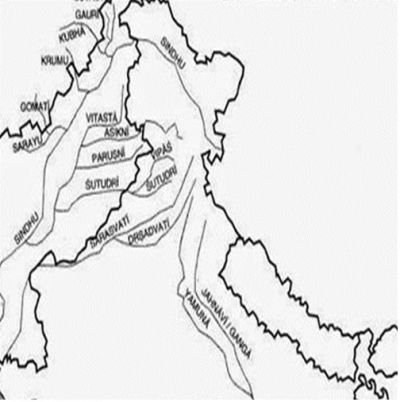 The Rivers mentioned in the Vedas
The Rivers mentioned in the Vedas
The Saraswati
The existence of River Saraswati has many implications, most importantly, the death of the AIT/AMT. The AIT/AMT proponents must deny River Saraswati and its identification with the present Ghaggar-Hakra. The Old Rig Veda speaks of Saraswati as a glowing and flowing river. The New Rig Veda gives more importance to the Indus River and speaks in celestial terms about Saraswati. The geography, flora, and fauna in the Old Rig Veda puts Saraswati at the place where the Ghaggar-Hakra flows today as Michel Danino shows (The Lost River).
Plate tectonics changed the flow of rivers, making the Saraswati dry. At the end of a mature urban phase of the Indus Valley Civilization (1900 BCE), a prosperous civilization along the Saraswati migrated towards the east and west. There is a large amount of archaeological evidence of different phases of a thriving civilization on the banks of Saraswati (going back to 7000 BCE), as shown elegantly by Danino. Archaeology, most importantly, shows no evidence of a forced invasion of any kind.
AIT/AMT proponents make the Saraswati a river in Afghanistan called Harahvaiti; and the sea mentioned in the Veda as a lake. There is a late and single record of Harahvaiti in Afghanistan. The Rigvedic-Avestan records more plausibly suggests people moving from Haryana to Afghanistan giving the name of Saraswati to a local river in Afghanistan. Some concentrate on a poetic reference (an exaggeration) to the waves of the powerful Saraswati bursting the ridges of the hills. Ghaggar-Hakra was never that powerful. Circularly, because Ghaggar-Hakra is weak, say the AIT scholars, it cannot be the Saraswati!
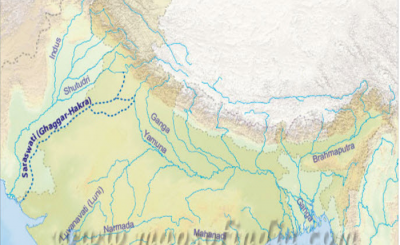
Archaeology
The most important source for rejecting the Aryan theory comes from archaeology. Till date, there is not a shred of evidence supporting the invasion or migration scenario. Unfortunately, this Aryan theory became an established fact and selective words with fancy interpretations from the Vedic corpus became their supporting evidence. Words such as varna became color and a-nas became “without a nose” or “stub” nose to support many racial speculations of distinct Aryan and Dravidian races. Such interpretations laid the basis of physical anthropology studies. As Farek notes in his book, on a dubious interpretation of a single passage from the large Vedic corpus by Max Mueller, the promoter of anthropometry, H. H. Risley, claimed that the Vedic Aryans referred to their enemies as noseless.
Archaeology remained the biggest problem even as the Indus excavations (the Harappan and Mohenjo-Daro civilizations in the 1920s and the Mehrgarh excavations later) contradicted the Aryan theory. In fact, as the OIT group insists, all the evidence (archaeology, textual, Vedic, inscriptions, astronomical) has suggested not only an indigenous Vedic civilization without any Aryan-Dravidian divide but even a possible reverse migration from India to other parts of Europe. But in the dominant academic circles, the idea of Aryan invasion remains a primary assumption which they will not let be falsified by new findings.
The mature Harappan urban phase (2600–1900 BCE) covered an area of about one million square kilometres and there are over 1,200 excavated sites along the Saraswati river bed. Surprisingly, by 1900 BCE, most of a thriving civilization had stopped functioning. The explanations have varied including an economic decline from the evidence of an end of thriving trade with Mesopotamia in 2000 BCE. The plausible explanation seems to be a drying up of Saraswati around 1900 BCE which might have led to severe drought conditions. Harappans also may have accelerated the region’s ecological degradation through deforestation.
The time gap between 1900 BCE (end of Indus civilization) and 1500 BCE (supposed arrival of the Aryans) shows that, in any case, the latter could not have been the cause of the Harappan decline. Most startling is the absence of archaeological evidence of a possible Aryan invasion. Prominent, well-known archaeologists repeatedly affirm that the Aryans defy any archaeological definition. So far, no type of artefact, and no class of pottery exists that would enable us to say, “Aryans came this way”.
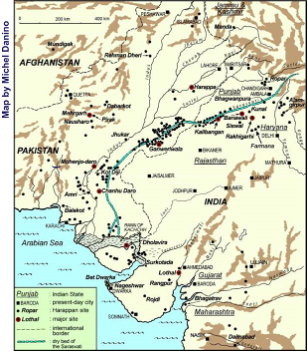 A thriving civilization along the River Saraswati
A thriving civilization along the River Saraswati
Archaeology and Texts: Why Is the Period 2000-1000 BCE Significant and Important?
Aryan or the Indo-European migration theory is only and solely based on linguistic analysis. Discovery of common linguistic features between Northern Indian and many European languages logically pointed to a common origin of languages in a geographically-restricted “Homeland”. As Talageri explicates clearly in his books and essays, the twelve living and extinct branches of Indo-European languages from the west to the east are: Celtic, Italian, Germanic, Baltic, Slavic, Albanian, Greek, Anatolian (extinct), Armenian, Iranian, Tocharian (extinct), and Indo-Aryan. The common ancestral language gets the term PIE (Proto-Indo-European).
The theorized timeline, as Talageri explains, is as follows:
- Around 3000 BCE, from the “Homeland,” the Anatolian and the Tocharian branches separated. Then the European branches separated as following: Italic, Celtic, Germanic, Baltic, and Slavic. The five last branches to remain in the “Homeland” were Albanian, Hellenic (Greek), Armenian, Iranian, and Indo-Aryan.
- The Indo-Aryan (or the Vedic people) and the Iranian branches have many common linguistic, textual, ritual, and religious features as the Rig Veda and the Avesta show. This combined family, long after 3000 BCE, migrated together from the Steppes to the Central Asian (Bactria) region.
- Then, Indo-Aryans separated from the Iranian branch and migrated towards the Saptasindhu area/ northern Pakistan, into the area of the Harappans. Around 2000 BCE, the Indo-Aryans went across the Ural Mountain range and spread eastwards.
- Finally, between 1400 BCE and 1000 BCE, the Aryans compiled the Rigv Veda. The Rig Veda had to be compiled before 600 BCE too, since by Buddha’s time, the entire Vedic literature was well in place.
As seen earlier, problematically, archaeology of the Harappan area shows an extremely stable civilization from 4500 BCE to 500 BCE without any cataclysmic changes effected by the forced entry of the Aryans. Talageri’s Rigvedic data shows no reference to any tradition, name, or place in memory of its previous journeys from the Russian steppes. Rivers in Europe carry the indigenous names even after the influx of European languages, but the names of rivers and places are purely Indo-Aryan in the Veda itself with no remnant of any original Dravidian name. The extensive Tamil Sangam literature does not even mention any great events of a populous Dravidian civilization leaving the area in a short span from 2000 BCE to 1200 BCE.
Following the Rig Veda, each of the other Samhitas (Yajurveda, Samaveda, Atharvaveda), the Brahmanas, the Aranyakas, the Upanishads, and the Sutras have their own chronological periods showing linguistic changes of different periods of time — but all before the Buddha. This remarkably squeezes the entire period of the Vedic corpus into a narrow window of 400-600 years. For the AIT/AMT to hold, 2000 BCE to 1000 BCE is the extremely important period when everything related to Aryan migration into India happened. Archaeology, textual-inscriptional analysis, and linguistics problematically, for the AIT/AMT that is, show the presence of Indo-Aryans much before 2000 BCE, and in fact, point towards a reverse migration out of India.
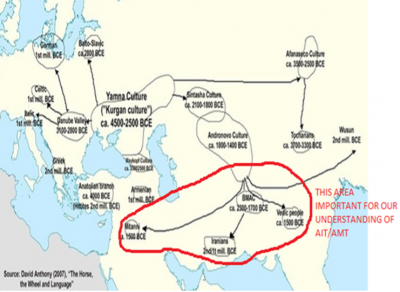
The Horse
The presence or absence of the horse in Harappan Civilization has been a source of continuous debate. The basic argument goes like this: Rig Veda uses the word “asva” over 200 times. Hence, the Vedic society must have been full of horses. Horse remains have been conspicuously absent in Harappan Civilization archaeology and therefore Harappans are both pre-Vedic and non-Aryan. The horse came to India around 1500 BCE brought by the Indo-Aryans, who used its speed to crushing advantage in order to subdue the native, ox-driven populations. This line of reasoning is most self-evident and claimed to be “fool proof” in scholarly writings of the AIT/AMT proponents. Danino (The Horse and The Aryan Debate) shows that there are serious flaws at every step of the argument. He shows elegantly how there has been cherry-picking of data that ignores the horse remains from various protohistoric sites along with problems of methodology, especially in the persistent misreading of the Rig Veda.
The horse, “central to Vedic culture,” seems to have accompanied the migrating Aryans, according to the AIT proponents. They assert to the near absence of horses in both the excavated Indus cities and in the Harappan cultural depictions as proof that the original Harappans did not compose the Vedas. This is a tenuous argument where the absence of evidence becomes the evidence of absence. As Michel Danino says, at least 12 Harappan sites (as well as a few Neolithic and pre-Harappan sites) have yielded horse bones and teeth confirmed by archaeo-zoologists like Sandor Bokonyi, an authority on the prehistory of the horse.
Harappan seals may not depict the horse but neither do they depict lions, cows, camels, wolves, cats, or jackals, all known to the Harappans. Depiction and non-depiction simply may be a cultural choice; not a proof of existence or non-existence. In the Aryan scenario, we should see an increase of horse remains and depictions after 1500 BCE; the depiction of the horse remains largely absent until the Mauryan age (321 BCE-185 BCE), more than a thousand years later! There is no radical archaeological change between pre-1500 and post-1500 BCE for horses.
In the Rig Veda, the adversaries (Dāsyus) also have “horses” — even a marker for them in some passages. The equation horse equals Aryan is therefore invalid. The metaphors also need an understanding as Sri Aurobindo pointed out. According to him, ashva often does not refer to the animal, but for energy and speed, just as gou (cow) is often a metaphor for “light”. Chess sets beyond 2000 BCE depicting horses at Lothal, and linguistic evidence that the horse was well known to the non-Indo-European language speakers of India before the Aryans supposedly came show that the horse did exist in India. Only the proof of its existence seems to be rare, for whatever reasons. Some scholars suggest that in the Vedic society the ownership of horses was a rarity, reserved for aristocrats and kings. If such is the case, then the Harappan civilization cannot be seen as separate from Vedic culture on grounds of the horse argument alone.
Cultural and Linguistic Issues
Cultural Breaks
The fertile Gangetic-Vindhya civilization flowered a few centuries after the fading of the Harappan civilization and with the slow migration of the settlers. In the Aryan paradigm however, the Ganga-Vindhya civilization is completely disconnected from the Harappan; an independent settling place for the Aryans after the Harappans vanished. The Aryan theory demands a distinct break in the civilizational continuity. However, recent archaeological work shows a substantial Harappan cultural legacy in the Gangetic civilization of the first millennium BCE. House designs, trapezoid shaped bricks, coins, weight measures, craft traditions, ornaments, iconography, fire altars, tree worship, mother-goddess worship, and figurines pointing to yogic and meditation practices suggest a cultural continuum of the Harappan civilization into the Gangetic civilization without any break. Archaeologist John Marshall (1931) says, “The [Harappan] religion is so characteristically Indian as hardly to be distinguished from still living Hinduism”.
Linguistics
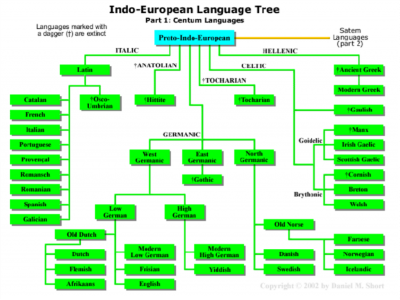
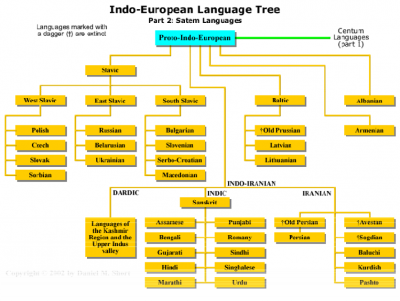
The flow-charts by Daniel M Short shows the western and eastern branches of the PIE language family. The Indo-European (IE) and the Dravidian languages dominate India’s linguistic families. The Dravidian languages (mainly Tamil), dominating the southern part of India, though interacting with Indo-European languages in an organic manner over many centuries, show a separate origin and an independent evolution.
Most linguistic theories assumed a defined homeland and a defined people speaking this PIE language. Problematically, linguists have been unable to agree on the homeland’s location. Linguists have proposed over twenty places at different times. One scholar conceded that the quagmire of speculation and disagreement has been characteristic of the Indo-European homeland quest since its inception. Regarding the dating of the PIE, theories propose from 4000 BCE to 7000 BCE, but the evidence is a house of cards. One linguist, Dixon, says that the only honest answer to questions about dating a proto-language is “We do not know”.
One linguist calls PIE reconstruction a fiction; another feels that scholars ignore, minimize, or justify at any cost when they confront data contradicting the IE theory. As James Clackson says, “from the linguistic data alone, without considering the evidence of archaeology or early texts, it is not possible to draw definite conclusions about the homeland of the speakers or Proto-Indo-European or even the age of the language family”. Clearly, the migrations of people may be completely independent of the migration of languages. The AIT scholars generally exclude India because of the “centre of gravity” argument – with the Indian languages thought to be “too far” on the periphery of the IE family.
Linguistics: Were the Harappans Dravidian-Language Speakers?
The confusion between language and “race” persists till date. German nationalism in the 19th century took the theme of a “pure Aryan” ancestral race which later became the ideological foundation for Nazism. Scholars try to show that the development of comparative philology (or study of languages) preceded anthropology; and that it was only the latter that gave rise to race theories. However, Vishwa Adluri and Joydeep Bagchee (authors of The Nay Science) emphatically show that racism in the humanities clearly started with linguistic studies and Indology in the German universities. More recent versions have abandoned the “race” concept, keeping only the arrival of “Indo-Aryan” speakers.
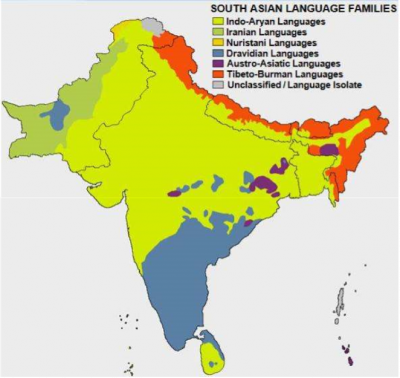
The Indus or the Harappan script is the oldest but undeciphered script in the world predating the Indo-Iranian languages, Sanskrit, and even the southern Dravidian languages. AIT proponents claim that the Aryans came (who later developed Sanskrit) and drove Harappans (speaking the Indus language) down south where the latter’s language developed into the Dravidian languages. The link between Harappan language to both north Indian and Dravidian language families remains weak even today. As Talageri says, in the absence of any recorded foreign invasions historically, the Indus or Harappan language would perhaps qualify as an ancestor to all languages used in the same region later. But that would be a deathblow to the entire edifice of the Aryan-Dravidian debate and the standard story where the Aryans forced their way into a separate Harappan culture with a different language.
The north-to-south movement of Dravidians is a vital component for the AIT proponents. The resemblance of the word “palli” (village or hamlet) in Dravidian languages to the word “oli” or “vali” for name places in Maharashtra is offered as proof for the Dravidian migration from the north to the south of the Vindhyas. This is strange reasoning, according to Talageri, because if words can denote geographical migrations, then the Greek place name suffix “polis” (Persepolis, Heliopolis, Annapolis) can also derive from the same word “palli” implying even a westward migration of the Greeks from a Dravidian area to Greece!
For the Aryan theorists, Brahui, a surprising Dravidian language spoken in parts of Baluchistan, becomes a Harappan relic and proof that the Harappan language was Dravidian. They explain this as some “pastoralists” staying back while a majority “urbanites” moved south. These speculative ideas are contradictory because it was the Aryans who were clearly the wandering pastoralists. This also becomes strange because the Rig Veda they composed is the output of rather well-fed priests in a prosperous urban community according to scholars, says Shrikant Talageri. Brahui, however, clearly is a recent import into the region, going back no more than 1,000 years. Linguistic pockets prove nothing without a historical perspective: the presence of an Anglo-Indian community in the Nilgiris of Tamil Nadu does not indicate that Tamil Nadu’s earliest language was English!
In the next section, we will consider the evidence from archeoastronomy and genetics in settling the Aryan debate. Archeoastronomy is an important field to date our scriptures. Our scriptures characteristically do not give exact dates of their composition but many times give the exact positions of the stars and planets during the various events described. That gives enough clues to chronological dating of the scriptures. It is a simple Occam’s razor principle to assume that the poets described the positions of the stars as they observed and not as when they may have existed in the distant past! Genetics is of course the new superstar.

